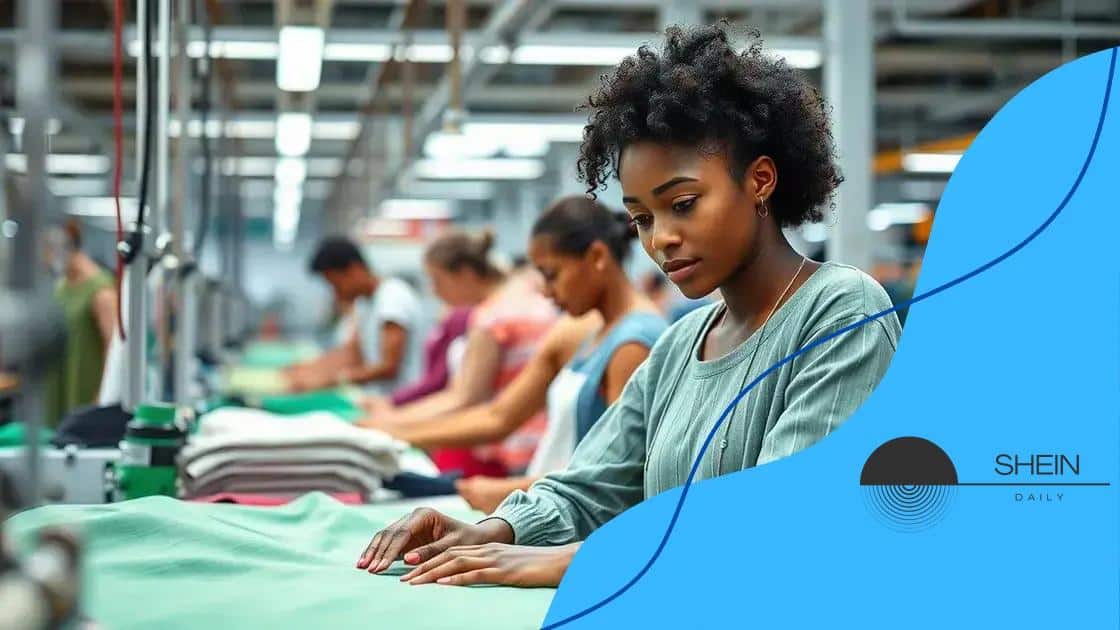Shein’s investment in sustainable production practices

Shein’s investment in sustainable production practices focuses on eco-friendly materials, transparency in supply chains, and consumer engagement to reduce environmental impact and meet growing customer demands for responsibility in fashion.
Shein’s investment in sustainable production practices signals a significant shift in the fashion industry. You might wonder, how does this affect your wardrobe choices? Let’s uncover the details.
Understanding Shein’s sustainability goals
Understanding Shein’s sustainability goals is crucial as this fast-fashion giant seeks to make a positive impact on the environment. With the growing concerns about environmental damage, Shein is taking steps to address these issues.
Many consumers are eager to learn how their favorite brands are contributing to sustainability. Shein aims to create an eco-friendly future by implementing various strategies to reduce waste and minimize carbon footprints.
Key Sustainability Initiatives
Shein has set out several important initiatives to promote sustainability:
- Recycling materials to create new products.
- Reducing plastic usage in packaging.
- Implementing energy-efficient manufacturing processes.
- Encouraging a circular fashion economy.
These initiatives represent a significant step toward sustainable production in the fashion industry. As Shein evolves, it focuses on transparency, helping consumers understand the origin of their clothing and its environmental impact.
Understanding these goals can empower consumers to make informed choices. By opting for brands committed to sustainability, shoppers can encourage positive change within the industry. This aligns well with the growing trend towards responsible consumerism.
Measuring Success in Sustainability
To ensure the success of their sustainability goals, Shein must establish clear metrics. These metrics can include:
- Reduction in overall waste produced.
- Improvement in energy consumption efficiency.
- Increased percentage of recycled materials used in products.
- Consumer awareness and participation in sustainability programs.
Achieving these goals involves continuous assessment and adaptation. By prioritizing environmentally friendly practices, Shein not only meets consumer demand but also plays a role in shaping a more sustainable fashion landscape.
The impact of sustainable practices in fashion
The impact of sustainable practices in fashion is becoming increasingly important as consumers demand more responsibility from brands. As a result, companies like Shein are responding with innovative approaches that benefit both the environment and their customers.
Sustainable practices not only help reduce environmental harm but also encourage ethical labor conditions. As brands shift to more sustainable methods, they start redefining industry standards. This transition is vital for reducing textile waste and lowering carbon emissions.
Environmental Benefits
Implementing sustainable practices leads to numerous environmental benefits:
- Reduction of waste in landfills.
- Conservation of water resources.
- Less reliance on harmful chemicals.
- Decreased carbon footprint in production.
By adopting these strategies, the fashion industry can drastically minimize its environmental impact. Often, consumers can notice these changes reflected in product quality and company transparency.
Economic Advantages
Beyond environmental effects, there are significant economic advantages as well. Companies that embrace sustainability often:
- Attract a loyal consumer base.
- Enhance their brand image.
- Reduce costs in the long run through efficient practices.
- Open new markets focused on eco-conscious products.
By investing in sustainable practices, brands can find a balance between profitability and ecological responsibility. The shift to sustainability may also lead to innovation within the industry, giving rise to new materials and technologies.
As sustainability becomes a key focus, consumers increasingly gravitate toward brands that prioritize ethical production. This change is evident in shopping habits, where more people are willing to pay a premium for products that support a healthier planet. As more brands recognize this trend, they will be compelled to further innovate their practices.
Consumer response to sustainable clothing

Consumer response to sustainable clothing has evolved significantly in recent years. As awareness of environmental issues grows, shoppers are more inclined to support brands that prioritize ethical practices. Many consumers are eager to know how their clothing choices affect the planet.
Today, shoppers often seek out brands that demonstrate commitment to sustainability. This shift is evident in various markets worldwide, where eco-friendly labels and practices resonate with a larger audience. The importance of transparency and ethical production has never been greater.
Shifting Consumer Preferences
More people are choosing sustainable clothing because they are aware of its benefits. This change in preference can be highlighted by these key trends:
- Increased demand for eco-friendly fabrics and materials.
- Willingness to pay more for sustainable products.
- A focus on brands with clear sustainability goals.
- A preference for second-hand and upcycled clothing options.
As these preferences shape the market, brands that ignore sustainability risk losing customers. Shoppers actively seek information about the environmental impact of their purchases, which encourages brands to adapt.
The Role of Social Media
Social media plays a crucial role in shaping opinions about fashion and sustainability. Platforms like Instagram and TikTok showcase sustainable brands, creating visibility and consumer engagement. Influencers share stories about sustainable clothing, encouraging their followers to consider the environmental impact of their choices.
As a result, the dialogue around sustainable clothing has expanded, leading many consumers to reassess their shopping habits. This awareness often translates into increased pressure on companies to improve their practices.
In response, brands like Shein are not only adopting sustainable practices but also marketing these initiatives. They recognize the growing consumer demand for eco-conscious fashion and strive to meet these expectations.
Challenges faced in sustainability efforts
Many brands, including Shein, face various challenges in their sustainability efforts. While the push for eco-friendly practices grows, companies must navigate obstacles that can hinder their progress. Understanding these challenges is crucial for consumers and businesses alike.
One major obstacle is the cost associated with implementing sustainable practices. Developing and sourcing eco-friendly materials can be significantly more expensive than traditional methods. This often leads brands to make tough decisions about pricing and product offerings.
Supply Chain Complexities
Another challenge arises within the supply chain. Ensuring that every step, from raw material sourcing to production, aligns with sustainable values can be difficult. Some specific issues include:
- Difficulty in tracking the sustainability of materials.
- Limited access to ethical suppliers.
- Complicated manufacturing processes that don’t prioritize sustainability.
- Pressure to maintain fast production times while adopting eco-friendly methods.
Balancing these factors can create tensions within a brand’s operations, making it hard to fully commit to sustainability.
Consumer Expectations and Education
Consumer expectations also present a challenge. Many shoppers seek out sustainable options but may not fully understand what that means. Some consumers expect affordable prices while demanding high-quality, ethically produced clothing. This creates a paradox where brands feel pressure to meet consumer demands without compromising their sustainability goals.
Additionally, spreading awareness about sustainability issues is essential. Many consumers are still unaware of the benefits of choosing sustainable clothing. Addressing this knowledge gap is crucial for encouraging responsible purchasing behaviors.
Brands must not only improve their practices but also effectively communicate their sustainability efforts. Transparency is key. Customers want to know how their clothing is made and the materials used. Failing to provide this information can lead to distrust and brand loyalty issues.
Future of sustainable production at Shein
The future of sustainable production at Shein looks promising as the brand continues to adapt to changing consumer preferences and environmental concerns. As sustainability moves to the forefront of fashion, Shein is taking bold steps to integrate eco-friendly practices into its operations.
One key focus for Shein is developing new materials that are both stylish and sustainable. This includes using recycled fibers and fabrics that minimize the use of resources. By investing in innovative materials, Shein aims to reduce its carbon footprint while offering appealing products.
Commitment to Transparency
Another important aspect is Shein’s commitment to transparency. As consumers increasingly demand information about the origins of their clothing, Shein plans to improve its supply chain visibility. This means:
- Providing clear information about sourcing and production methods.
- Engaging with third-party audits for better accountability.
- Eliminating practices that compromise ethical standards.
- Focusing on local sourcing to reduce shipping emissions.
By being more transparent, Shein can build trust with consumers and enhance its reputation in the market.
Engaging Consumers in Sustainability
Shein recognizes the importance of engaging consumers in sustainability efforts. The brand plans to introduce programs that encourage responsible consumption. These initiatives may include:
- Promoting clothing recycling options.
- Encouraging customers to choose eco-friendly outfits.
- Offering incentives for sustainable purchases.
- Hosting campaigns focused on educating consumers about sustainability.
Through these efforts, Shein aims to create a community that values sustainability. The brand believes that by fostering a sense of responsibility among consumers, it can further drive positive change.
As the landscape of fashion continues to shift, Shein is poised to play a significant role in the transition toward sustainability. With ongoing investments in eco-friendly practices and consumer engagement, the brand aims to lead by example in the fast-fashion industry.
FAQ – Frequently Asked Questions about Shein’s Sustainability Practices
What initiatives is Shein taking to promote sustainability?
Shein is focusing on developing eco-friendly materials, enhancing supply chain transparency, and engaging consumers in sustainability programs.
How does Shein ensure that its products are sustainably sourced?
Shein aims to provide clear information about sourcing and production methods and engages in third-party audits to maintain accountability.
Why is transparency important for Shein?
Transparency helps build trust with consumers who want to know the origins of their clothing and understand its environmental impact.
What challenges does Shein face in its sustainability efforts?
Shein faces challenges such as the higher cost of sustainable materials, complex supply chain logistics, and meeting diverse consumer expectations.





